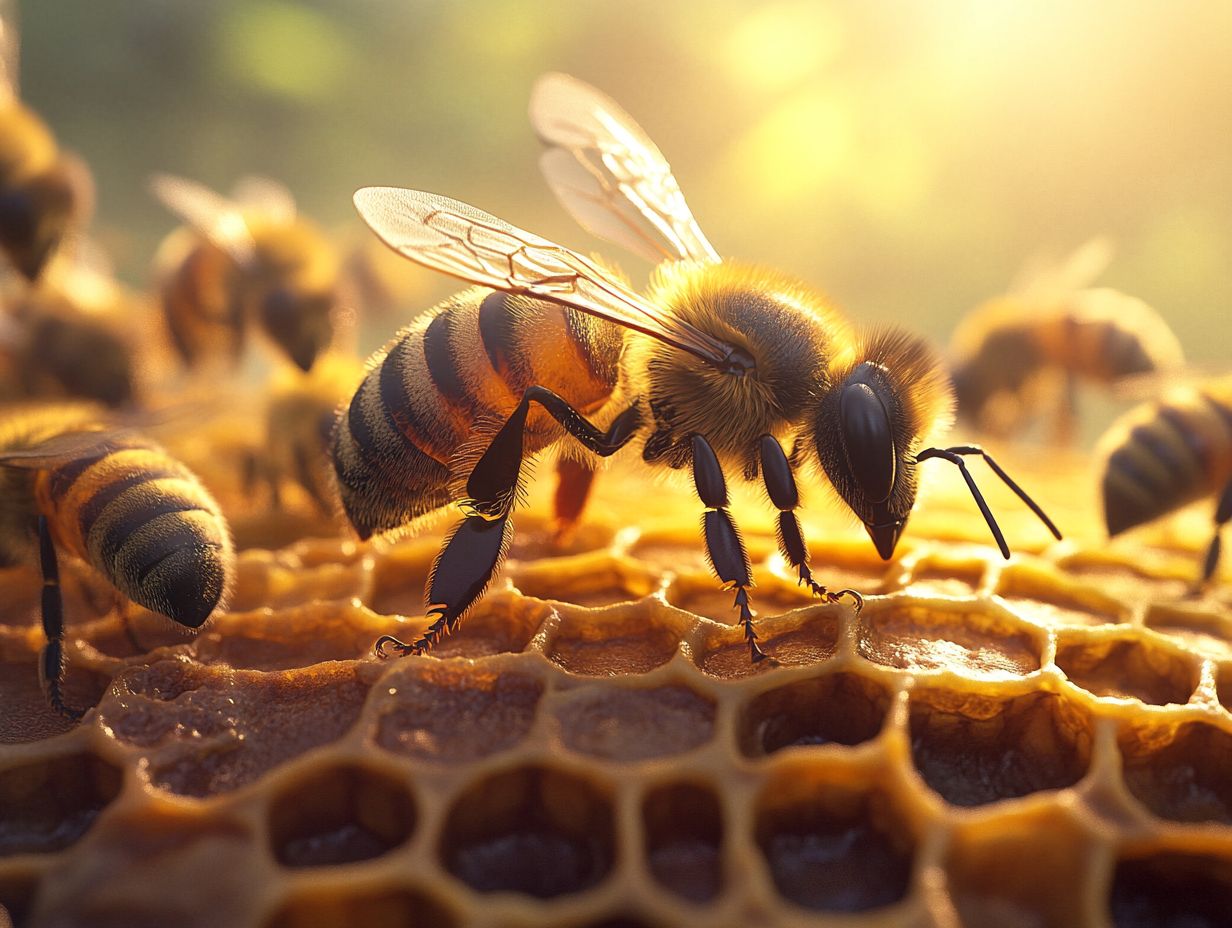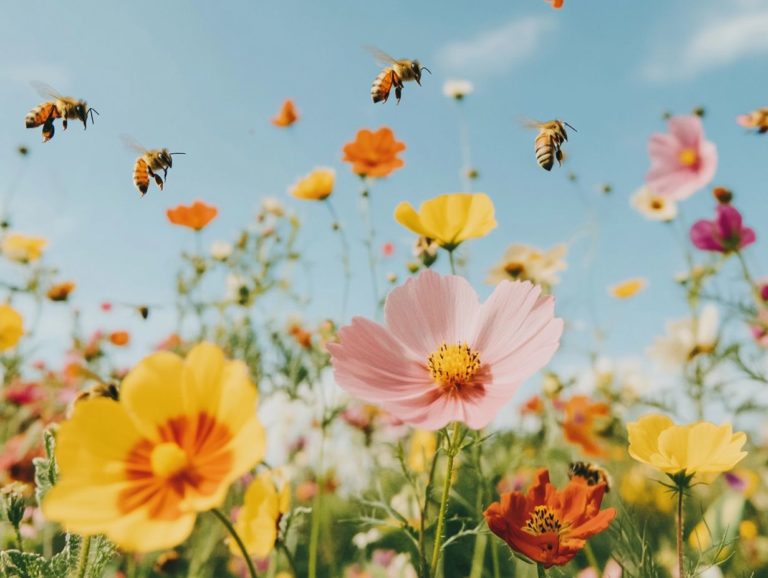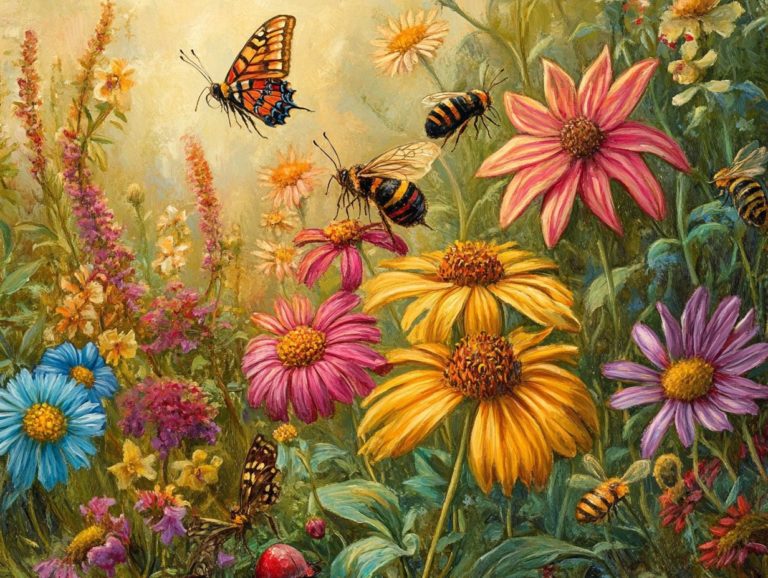What Happens During a Bee Dance?
Bees are truly remarkable creatures, and one of their most fascinating behaviors is the bee dance a complex form of communication that unveils how bees interact in their hive. This communication is often studied by scientists who study animal behavior, like Karl von Frisch.
This exploration delves into the details of bee dances, examining their various types and purposes, as well as the remarkable mechanics through which bees share crucial information about food sources, nectar sources, and potential dangers. These dances play a vital role in maintaining the hive and ensuring the survival of the entire colony.
Whether you re a devoted nature enthusiast or simply curious about the wonders of bee behavior, get ready to discover amazing new insights!
Contents
- Key Takeaways:
- What is the Bee Dance?
- Why Do Bees Dance?
- How Do Bees Communicate Through Dance?
- What Happens During the Bee Dance?
- What Are the Benefits of the Bee Dance?
- Can Humans Understand the Bee Dance?
- What Are the Similarities and Differences Between Bee Dance and Human Communication?
- Frequently Asked Questions About Bee Dance
Key Takeaways:

- The bee dance is a unique way bees communicate about food and dangers.
- The dance includes details about direction, distance, and nectar quality.
- Studying these dances helps scientists understand animal communication.
What is the Bee Dance?
The bee dance, especially the waggle dance, is a fascinating form of communication that honey bees (Apis mellifera) use to convey crucial information about resource locations, particularly nectar sources. Nectar sources refer to the sugary liquid produced by flowers that bees collect.
This remarkable social communication system enables bees to share details about the distance to these resources and the quality of the nectar with their colony members. By doing so, they ensure efficient foraging and successful pollen collection.
The dance, marked by a series of intricate movements, not only directs fellow bees but also plays an essential role in maintaining the overall health and productivity of the hive, crucial for pollen collection and nectar gathering.
What Are the Different Types of Bee Dances?
Every bee dance tells a story about food and survival. Honey bees employ two distinct types of dances: the waggle dance and the round dance, each serving a unique purpose in their intricate communication system.
The waggle dance is characterized by a figure-eight pattern, which conveys precise information about the location of food sources, detailing both distance and direction from the hive. As the bee performs this intricate movement, she waggles her body while orienting herself in relation to the sun, effectively pointing the way to the nectar or pollen. This dance is crucial for foraging behavior and optimizing resource gathering.
On the other hand, the round dance is used for resources that are in close proximity to the hive, typically within a short distance. In this dance, the bee moves in a circular motion, signaling to her companions that a food source is nearby, although she doesn t provide specific directions.
Both dances are essential to the social structure of the colony, facilitating efficient foraging and resource gathering through effective communication among the bees.
Why Do Bees Dance?
Bees engage in a fascinating dance primarily to convey vital information about resource locations, especially when it comes to nectar sources and opportunities for pollen collection. This intricate method of social communication is not just a charming spectacle; it plays a crucial role in the survival of their colony.
By enhancing foraging behavior, the dance significantly boosts the overall efficiency of resource utilization within the hive, ensuring that every member benefits from the bounty nature provides. It also includes complex communication about flower species and nectar quality.
Next time you see bees buzzing around, take a moment to observe their dances and appreciate their incredible communication!
What Are the Purposes of the Bee Dance?
The primary purposes of the bee dance are to communicate the locations of high-quality nectar sources. It also informs colony members about the distance to these resources and coordinates efficient foraging behavior. This social communication is vital for the collective success of the colony.
As a forager bee performs complex movements, it relays critical information to its companions, significantly enhancing the overall effectiveness of the colony s resource collection efforts. The angle and duration of the dance provide essential clues about the direction and abundance of flowers, enabling other bees to quickly assess the value of potential foraging sites. This method is particularly vital for locating flower patches in different environmental conditions.
This remarkable form of communication not only refines foraging strategies but also cultivates a sense of collaboration among colony members, ensuring that the hive makes the most of available resources to sustain their growing population. In essence, these dances are vital to the survival and productivity of the bee colony.
How Do Bees Communicate Through Dance?
You may be surprised to learn that bees possess an intricate system of communication through their dance movements, especially the waggle run. This fascinating dance shares crucial information about resource locations, distances, and various flower species to their fellow colony members. These dances are crucial for the survival and productivity of the hive.
By using visual cues and positioning in relation to the sun, these bees effectively communicate the essential details necessary for successful foraging, making the dance a sophisticated form of bee communication.
What Are the Different Components of the Bee Dance?

The various components of the bee dance, such as the waggle run and round dance, are essential for communicating vital information about resource location and quality to other bees. These dances are a key part of the social structure of the colony.
These dances are intricate forms of communication that enable honeybees to relay crucial details regarding the distance and direction of food sources. The waggle run, with its distinctive figure-eight movement, allows the dancing bee to indicate specific distances through the duration of the waggle phase. Meanwhile, the subsequent round dance signals the presence of nearby resources.
The intensity and frequency of these dances can reveal the quality and abundance of food, ultimately influencing foraging behavior. Together, these elements form a complex language that transforms individual discoveries into collective knowledge, ensuring that the entire colony can efficiently capitalize on the resources available in their environment. This intricate system of communication is a testament to the ethological complexity of bees.
What Are the Factors That Affect the Bee Dance?
Several factors can significantly impact the bee dance, including the specific bee species, the quality of available nectar, and the distance to resource locations.
These variables also play a role, as environmental conditions like temperature and wind speed also play crucial roles in determining the effectiveness of their dance communication. For instance, you might notice that warmer temperatures can enhance the bees’ metabolic processes, enabling them to perform more vigorous dances that convey richer information about the locations of resources. These factors are particularly important in the tropics where bees’ behavior can vary significantly.
The age and experience of dancer bees can influence how well the dance is executed and interpreted, directly impacting foraging success. These multifaceted influences underscore the dynamic nature of bee communication and highlight the complexity inherent in their foraging strategies, including how they adapt to environmental changes. This complexity is evident in the diverse ways bees utilize their communication methods to optimize resource gathering!
What Happens During the Bee Dance?
During the bee dance, especially the waggle dance, you ll witness bees engaging in remarkable movements that communicate crucial details about where to find food. They share the exact location and quality of nectar with their fellow colony members. This enhances the efficiency of the hive by allowing bees to navigate flower patches and optimize pollen collection.
How Do Bees Use the Bee Dance to Find Food?
Bees use the bee dance to locate food, deftly communicating the locations of nectar sources and flower patches to their fellow foragers. This enables highly effective and targeted foraging behavior. The dance is a complex movement that shows direction and helps them navigate distances.
Through intricate movements, like mesmerizing figures-eight patterns, the dancer conveys essential details that shape the foraging strategies of her companions. The angle of the dance in relation to the sun indicates the direction to fly, while the duration and intensity of her movements show the distance and abundance of nectar. This system of bee communication is crucial for their survival.
These shared insights help bees forage more effectively, dramatically enhancing the hive’s overall efficiency and improving their chances of survival.
How Do Bees Use the Bee Dance to Communicate Danger?
In addition to finding food, bees utilize the bee dance as a sophisticated means of communicating danger, signaling any threats they encounter near the hive entrance. This dance helps bees adapt their behavior based on environmental context.
This remarkable communication features intricate movements and variations in dance patterns that allow foraging bees to relay essential information about specific hazards, such as predators or environmental dangers. By adjusting the intensity and duration of their movements, bees effectively convey the level of threat they have detected, prompting others to exercise caution or change their foraging routes. This communication system is vital for the safety and efficiency of the hive.
This adaptability is crucial for the safety of individual foragers and the entire hive. By fostering collective awareness, honey bees can reduce risks and enhance overall survival. These dance signals significantly influence the bees’ foraging behavior, enabling them to navigate their surroundings carefully and ensuring the prosperity of their colony.
What Are the Benefits of the Bee Dance?
The benefits of the bee dance are numerous. It enhances foraging behavior, improves resource location, and strengthens social bonds among colony members. These factors contribute to the overall health and productivity of the hive by ensuring efficient nectar and pollen collection.
How Does the Bee Dance Help Maintain the Hive?

The bee dance is essential for maintaining the hive and ensuring that every member efficiently gathers resources needed for their communal lifestyle. This includes assessing nectar quality and communicating visual cues about resources.
Through intricate movements and specific patterns, bees convey vital information about the location of flowering plants, showcasing their remarkable navigation skills. This unique communication not only directs fellow bees to food sources but also influences the prioritization of flowers based on factors like distance and the amount of nectar in flowers. The waggle dance plays a key role in this.
The entire process exemplifies collaboration within the hive, as bees unite their efforts to maximize foraging success. By adapting their dance to various environmental conditions, they enhance the hive’s overall health and resource availability, highlighting the profound impact of this behavioral phenomenon on their survival.
How Does the Bee Dance Contribute to the Survival of the Colony?
The bee dance plays a crucial role in the survival of the colony. It enables effective communication about resource locations and ensures that gathering food efforts are optimized.
This communication involves sharing distance information and the quality of nectar sources. The intricate dance conveys essential information regarding the direction of food sources while cultivating a strong social structure within the hive.
As worker bees engage in these dances, they enhance cooperation and efficiency during foraging excursions. This shared understanding ensures that various resources like nectar and pollen are efficiently collected. Such synchronized efforts are vital in competitive environments, where access to nectar and pollen can be the key to the hive’s survival!
The nuances of the dance like the waggle dance and round dance showcase the bees remarkable ability to adapt their strategies. This ultimately leads to better resource acquisition and promotes the long-term survival of the entire colony. Each waggle run within the dance communicates specific details about the nectar source.
Can Humans Understand the Bee Dance?
You can gain profound insights into the fascinating world of the bee dance thanks to the groundbreaking research of ethologist Karl von Frisch. He revealed how honey bees communicate vital information about their surroundings through these elaborate movements, showcasing a remarkable form of communication in nature.
The species Apis mellifera, in particular, demonstrates these behaviors vividly. Have you ever wondered what secrets lie within their dances?
How Have Scientists Studied and Interpreted the Bee Dance?
Scientists have delved deep into the fascinating world of the bee dance, building on the pioneering insights of Karl von Frisch to decode the intricate communication methods of honey bees.
Their methods are varied and meticulous. Picture researchers in the field, closely observing the unique movements of the waggle dance, or conducting controlled experiments in laboratories. They seek to uncover how environmental factors influence these behaviors.
By using video recordings and motion tracking technology, scientists analyze each bee’s movements meticulously. This helps them uncover valuable insights about distance, direction, and the quality of food sources. Notably, the quality of nectar and the specific flower species are crucial data points.
Through experimental designs that manipulate stimuli, scientists gain a clearer understanding of how bees adapt their dances to different conditions. This highlights their extraordinary cognitive abilities and social intricacies.
By weaving together these diverse methodologies, researchers unveil the complex language of bees. This allows you to appreciate their intelligence and ecological importance on a whole new level. This understanding extends to how bees behave in various climates, including the tropics.
What Are the Similarities and Differences Between Bee Dance and Human Communication?
The parallels and distinctions between bee dance and human communication offer fascinating insights into social communication strategies. Both species utilize complex methods to indicate resource locations.
Both exhibit unique ways of conveying information regarding resource locations and social interactions. This sheds light on how they connect and collaborate within their respective communities.
Frequently Asked Questions About Bee Dance
What Happens During a Bee Dance?

During a bee dance, honey bees communicate with each other by performing a series of movements and gestures, such as the waggle dance and round dance, to convey important information.
How do honey bees use dance to communicate?
Honey bees use dance to communicate the location and distance of a food source to other members of their colony. This intricate communication method is vital for efficient resource location and foraging behavior.
What types of dance do bees perform?
- The round dance
- The waggle dance
What is the purpose of the round dance?
The round dance quickly shows nearby nectar sources to colony members. It indicates a food source is close to the hive but doesn t provide direction or distance.
How does the waggle dance convey information?
The waggle dance is a complex way for bees to share essential details. It communicates direction, distance, and nectar quality through a figure-eight pattern.
Why is bee dance an important behavior for the survival of a colony?
The bee dance is vital! It ensures efficient communication and helps all bees find and gather food, which is crucial for the colony s survival, especially in competitive environments.






